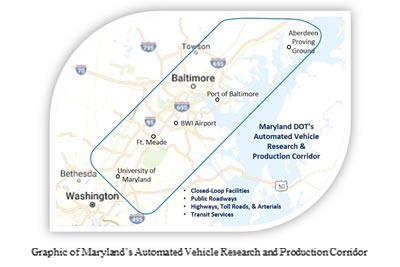Maryland Applies to US DOT for Automated Vehicle Testing

Maryland wants to be the next state to join the automated vehicle revolution.
On Dec. 21, Maryland Transportation Secretary Pete Rahn announced that the state had submitted an application to the U.S. Department of Transportation to designate a portion of the Interstate 95 corridor as a future testing and deployment area for automated vehicles.
Maryland’s DOT applied in response to USDOT’s notice that it intends to designate a select number of “proving grounds” across the country to help accelerate the development of automated vehicle technology.
Maryland’s proposal includes the I-95 corridor from Aberdeen Proving Ground to the Fort Meade/University of Maryland region and encompasses the Port of Baltimore and Baltimore-Washington International Airport.
“The I-95 corridor in Maryland is the ideal one-stop shop for real-world testing and deployment of autonomous vehicles,” Rahn said. “This corridor is strategically positioned along the thriving East Coast and combines a wealth of existing facilities, along with unique testing opportunities at the Port of Baltimore and BWI Airport.”
“MMTA is supportive of MDOT”s application and provided a letter stating such,” said Maryland Motor Truck Association President Louis Campion. “We believe autonomous vehicles have tremendous potential to enhance safety, improve efficiency and reduce congestion – all fundamental to the delivery of freight movement – and that Maryland has the potential to be a leader in that effort.”
Maryland’s proposal also relies on existing development, testing, partnerships and investments in automated vehicle technology along the I-95 corridor such as:
• Existing facilities already developing and testing automated vehicle technologies, including Aberdeen Proving Ground in Harford County, the Center for Entrepreneurship in Howard County and the University of Maryland’s Center for Advanced Transportation Technology Laboratory in Prince George’s County.
• MDOT-owned facilities to provide future simulated and real-world testing environments, including the electronic toll lanes along I-95, the Port of Baltimore for freight operations and BWI Airport for passenger shuttle transportation.
• Private-sector companies already planning development and the manufacturing of automated vehicle components within the next two years.
The application envisions facilities being ready to test by Jan. 1, 2018, with the idea of achieving a better understanding of the effects of automated and self-driving vehicles. Eligible entities include test tracks and testing facilities, race tracks, cities and urban areas, highway corridors and college campuses.
“We are in the process of developing clear policies and procedures for companies eager to test AV technologies on public roads in Maryland,” said Christine Nizer, MDOT’s Motor Vehicle administrator and chairwoman of the Maryland Autonomous and Connected Vehicle Working Group. “Self-driving vehicles have the potential to transform how we live and work, and while we are open for business and eager to realize the lifesaving and economic benefits of this innovative technology, we will always ensure safety comes first.”
The working group, which Rahn established in December 2015, includes such transportation stakeholders as elected officials, state and local agency representatives, highway safety organizations and representatives from the private sector and automotive industry.
The Nizer-led ensemble is charged with evaluating the latest research on automated and self-driving vehicles, as well as tracking federal and state laws, policies and programs, and coordinating with other agencies, organizations and businesses in Maryland.
USDOT will announce the initial list of automated vehicle proving grounds during the first quarter of 2017.

